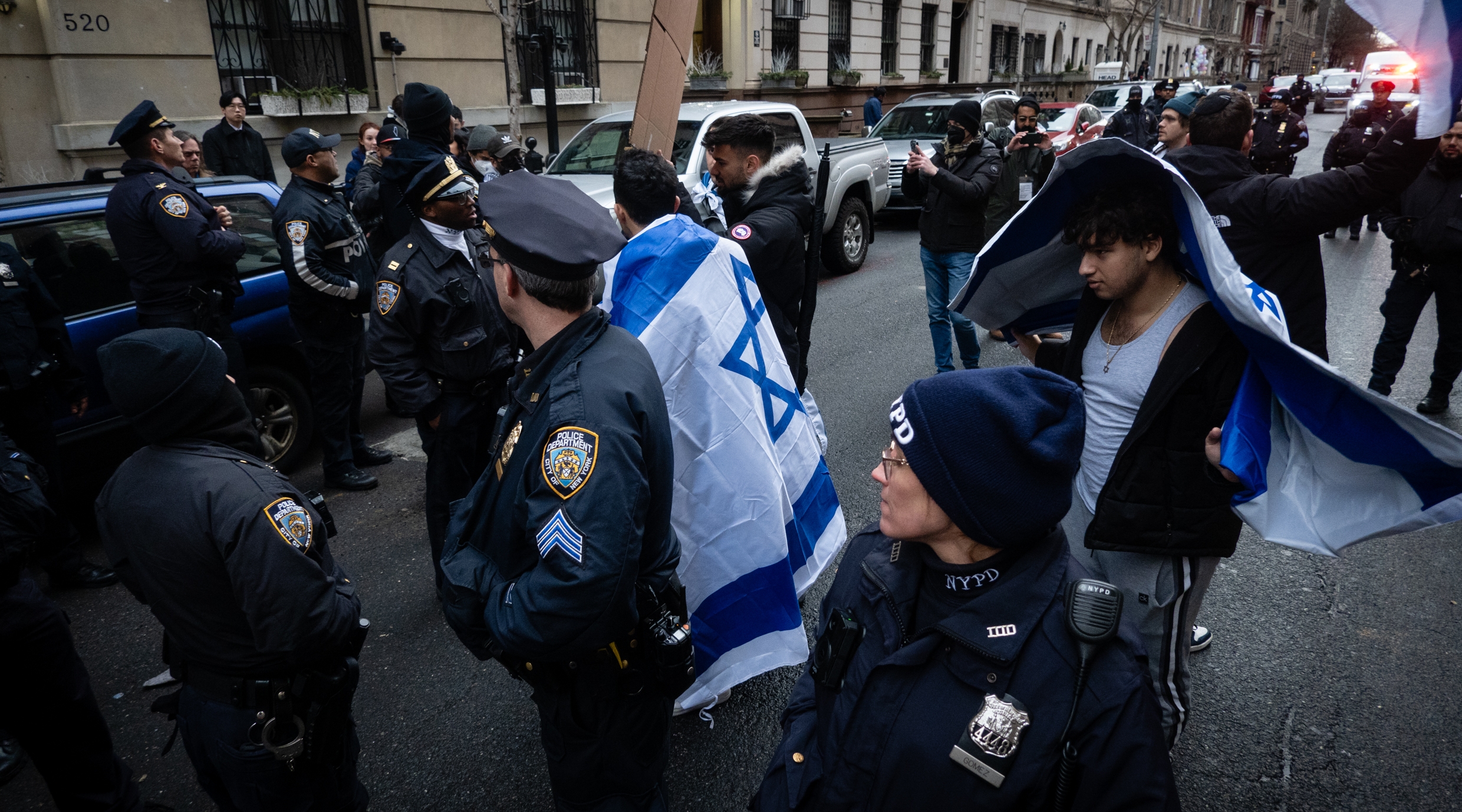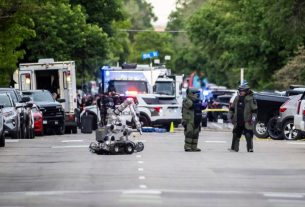((JEWISH REVIEW)) — The number of antisemitic incidents more than doubled last year, shooting up particularly following Hamas’ Oct. 7 attack on Israel, according to the Anti-Defamation League’s annual audit.
The ADL and other Jewish organizations, in addition to law enforcement agencies, have reported a spike in antisemitism after Oct. 7, as protests against Israel have taken place across the country.
But the ADL report found that antisemitic incidents were rising prior to Oct. 7, and that even after the outbreak of the Israel-Hamas war, nearly half of the reported incidents did not directly involve Israel.
The report, published Tuesday, tabulated a total of 8,873 incidents over the course of 2023. Of those, more than half — 5,204 — occurred after Oct. 7.
By contrast, the group tallied 3,697 incidents over all of 2022. At the time, that was a record in the more than 40 years since the ADL began issuing the reports. It has since been shattered.
Last year’s tally includes increases in the number of antisemitic assaults (161), acts of vandalism (2,177) and harassment (6,535). The number of swastikas reported, 1,117, represents a 41% increase from 2022. Ten percent of all anti-Jewish incidents, or 922, happened on college campuses.
Part of the increase in recent years is due to more robust reporting methods, such as including incidents reported by partner organizations, which started in 2021. Tuesday’s report also includes an update in the ADL’s methodology that classifies certain anti-Israel activities as antisemitic, which accounts for 15% of the annual total.
The ADL has come under fire from left-wing activists for portraying pro-Palestinian activism as antisemitism, a charge the group denies. But even without its methodology update, according to the report, 2023 still would have seen more than 7,000 acts of antisemitism, far more than any previous year. And the report says that even if all Israel-related incidents were removed, antisemitism still would have risen 65%.
“Antisemitism is nothing short of a national emergency, a five-alarm fire that is still raging across the country and in our local communities and campuses,” the CEO of the ADL, Jonathan Greenblatt, said in a statement. “Jewish Americans are being targeted for who they are at school, at work, on the street, in Jewish institutions and even at home. This crisis demands immediate action from every sector of society and every state in the union.”
To combat the rise in hate, the ADL is calling on governors to implement strategies to counter antisemitism in state-level programs analogous to the White House’s National Strategy to Counter Antisemitism released last year.
The report shows that even before Oct. 7, antisemitism was on the rise. From January to the beginning of October, there were 3,669 antisemitic incidents — close to the total for the entire previous year.
But the pace of incidents accelerated rapidly after Oct. 7. Just over half of them — 52% — directly concerned Israel. And the pace did not die down as the weeks passed following Oct. 7. The ADL found that there were 1,813 incidents in October, 1,575 in November and 1,938 in December.
The total number of post-Oct. 7 incidents, more than 5,200, is far higher than the 3,283 incidents tabulated during nearly the same period in a preliminary ADL report that was released in mid-January. The number of incidents grew much higher, an ADL spokesperson said, because law enforcement agencies and other groups that track hate take time to compile their own tallies.
The ADL altered its methodology after Oct. 7 to include in the tally “certain expressions of opposition to Zionism, as well as support for resistance against Israel or Zionists that could be perceived as supporting terrorism or attacks on Jews, Israelis or Zionists.”
One example of that, the group said, were images of hang gliders — which Hamas terrorists used to infiltrate Israel during the Oct. 7 massacre. Another was the slogan “From the river to the sea, Palestine will be free,” a common chant at pro-Palestinian rallies that many Jewish groups see as a call for the destruction of Israel.
The updated methodology accounted for 1,350 incidents, around a quarter of the post-Oct. 7 total, including 1,180 rallies.
Over the course of the whole year, 3,162 incidents, or 36% of the total, involved references to Israel or Zionism. That was a steep increase over 2022, when 241 incidents, or 6.5%, included anti-Israel sentiment.
At anti-Israel protests, the researchers cited antisemitic tropes, including accusations that Jews control the media or U.S. government, that Jews were involved in the 9/11 attacks, and accusations that Israel “harvests” Palestinian organs or imagery showing Israelis drinking blood, which the researchers linked to historical blood libels. Other speakers at protesters called Israelis and Zionists “bloodsuckers” or “parasites,” the report said.
At least one high-profile incident of harm to a Jew did not make the report. While the report tallied 161 incidents of antisemitic assault, it did not include the death of pro-Israel protester Paul Kessler because the circumstances are still under investigation.
Orthodox Jews, who tend to be more readily identifiable as Jewish, were targeted in 34% of assaults, despite, according to a 2021 Pew Research Center survey, making up around 9% of the Jewish population. Previous ADL reports have also found that Orthodox Jews are disproportionately victims of assault.
Nearly 2,000 incidents targeted Jewish institutions including synagogues, Jewish community centers and schools, a spike of 237% over 2022. The increase was partly due to a surge in bomb threats, mostly targeting synagogues. There were 1,009 bomb threats, up from only 91 in 2022.
On campuses, antisemitic incidents skyrocketed from 219 in 2022 to 922 last year — most of which occurred post-Oct. 7. The updated methodology accounted for more than a third of that total. In non-Jewish K-12 schools, antisemitic incidents also more than doubled.
White supremacist propaganda also surged, with 1,160 instances last year, compared to 852 in 2022. Most of those incidents were distributing fliers with antisemitic messaging. White supremacist groups also latched onto the Oct. 7 attack with propaganda that said “Death to Israel” and “End Jewish terror.” The most prominent of these groups was the Goyim Defense League, which was responsible for 529 instances of antisemitism.
California had the most recorded incidents, with 1,266, followed by New York, with 1,218, and New Jersey, with 830.
The report came a day after pro-Palestinian groups lashed out at Greenblatt and the ADL after he compared keffiyehs, or Palestinian headscarves, to Nazi armbands during an interview with MSNBC. More than 60 Muslim, Arab and Palestinian groups signed a letter calling the comments “hateful” and “dangerous.” The campaign echoes previous efforts urging civil rights groups to “Drop the ADL” as a partner.
The ADL, which has also faced criticism from the right in recent years, says it does not favor one side of the political spectrum over the other. It says it adheres to the International Holocaust Remembrance Alliance working definition of antisemitism, which has been endorsed by hundreds of countries, local governments, universities and corporations and has drawn criticism for classifying some Israel criticism as antisemitism.
ADL researchers compiled the data using information from victims, law enforcement, the media and partner organizations. The incidents include both criminal and non-criminal acts in public and private settings, and online incidents of harassment in cases of direct messages and some social media settings. “Sprees,” such as multiple instances of antisemitism at a single event, were counted only once.




